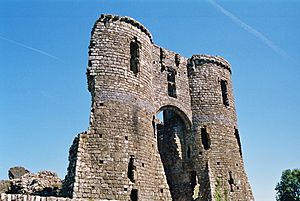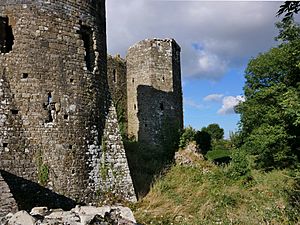Llawhaden Castle facts for kids
Llawhaden Castle (Welsh: Castell Llanhuadain) is a ruined castle in Llawhaden, Pembrokeshire, Wales. It's about 10 miles east of Haverfordwest. People believe an older type of castle, called a motte-and-bailey castle, was here first. The castle you see today was built by the bishops of St David in the 1200s.
The castle was left empty in the 1500s. Some of its stones were even taken to build other things nearby. Today, the castle is owned by the Lord of the Manor of Llawhaden. It is looked after by Cadw, a Welsh government group that cares for historic places.
What Llawhaden Castle Looks Like
The ruins of Llawhaden Castle stand on a hill. From here, you can see the River Cleddau. The parts of the castle that are still standing were built in the early 1200s.
The castle was protected by a deep ditch all around it. You could only cross this ditch using a drawbridge. The castle has a five-sided shape, like a pentagon. The north-western and western sides are gone now. But the other three sides are still there.
The main entrance, called the gatehouse, is on the southern side. It has two round towers and a big gateway. This is where the drawbridge would have been. It let people enter the castle's inside area. Cadw manages the ruins, and you can visit them.
The Castle's Story
Llawhaden and the land around it belonged to the Bishops of St David. They had owned this land for a very long time. After the Normans took over Wales, these lands became a special area called the Marcher Lordship of Dewisland. The Bishops ruled this area. It was the only Marcher Lordship ruled by church leaders. Marcher Lords had a lot of power, almost like kings!
The first Norman Bishop, Bernard, built a castle here in 1115. This was the year he became bishop. From this early castle, only a moat (ditch) and an earth bank remain. It was likely a motte-and-bailey castle.
The stone castle you see today was built later. Most of the ruins are from work done by Bishop Adam de Houghton. He ordered the building between 1362 and 1389. This new castle was much grander. It had two sets of living rooms on the first floor. The gatehouse you can see in pictures was probably added even later. More parts were added to the castle until the early 1500s, when Henry VIII was king.
The castle started to fall apart when Bishop William Barlow was in charge. He was the first Bishop after King Henry VIII changed the laws and ended the Marcher Lordships. Bishop Barlow wanted to change the church a lot. He was not very fond of St. David's and its old ways.
Barlow sold the lead from the castle roof. People say he did this to help pay for his daughter's marriage. This caused a lot of damage to the rest of the building. The castle never really got better after that. After King Henry VIII closed down many monasteries, the castle was completely left empty. It fell into ruin and its stones were used for other buildings.
In 1930, George Lansbury helped organize a group of 1,300 men who didn't have jobs. For six months, they worked to fix up several castles. Llawhaden Castle was one of them. They dug out moats and ditches. They also removed ivy and other plants that were growing on the castle.




